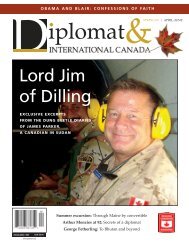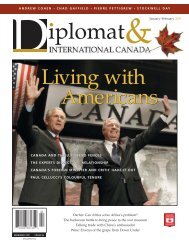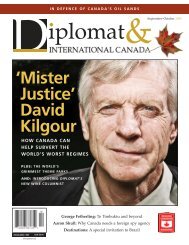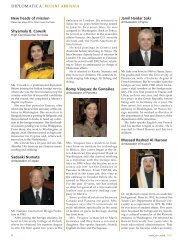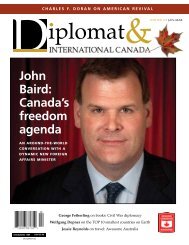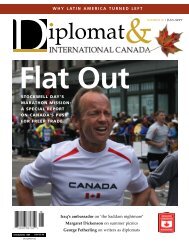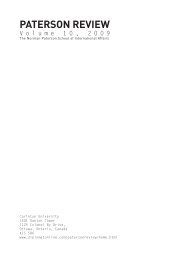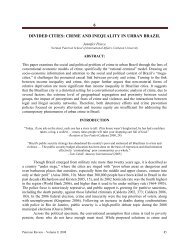the new petro power paradigm - Diplomat Magazine
the new petro power paradigm - Diplomat Magazine
the new petro power paradigm - Diplomat Magazine
Create successful ePaper yourself
Turn your PDF publications into a flip-book with our unique Google optimized e-Paper software.
DIPLOMATICA|DEBATE<br />
Guatemala’s No. 1 crisis: ‘drugs and thugs’<br />
By Georges de La Roche<br />
Guatemalan ambassador to Canada<br />
14<br />
In July 2010, Ecuador's police and members of <strong>the</strong> military worked with <strong>the</strong> U.S. drug enforcement<br />
administration to seize this submarine built to transport cocaine.<br />
Drug trafficking is eating away at<br />
our young democracies, corrupting<br />
our institutions and infecting<br />
our societies in general. Worse still,<br />
we have evolved from transit countries<br />
to consumers, making us a destination<br />
market while poisoning our youth and<br />
our future. This is because <strong>the</strong> narcos find<br />
it more convenient to pay in drugs than<br />
in cash.<br />
While trying to preserve modest advances<br />
in regional peace and democratic<br />
security, we are confronting a well-organized<br />
and better-financed adversary in<br />
<strong>the</strong> form of transnational organized crime,<br />
known to us as “drugs and thugs.” Guatemala<br />
and Central America are now in a<br />
turf war between organized crime cartels,<br />
resulting in more gruesome occurrences in<br />
<strong>the</strong> region. The region’s enemies are cartels<br />
that peddle anything outside <strong>the</strong> formal<br />
and legal sectors: drugs, contraband,<br />
people and weapons.<br />
Small governments, representing <strong>the</strong><br />
declared and formal market-state, struggle<br />
against <strong>the</strong> undeclared and informal, <strong>the</strong><br />
illegal and <strong>the</strong> illicit. If <strong>the</strong> classic definition<br />
of a state is “having a monopoly on <strong>the</strong> legitimate<br />
means or use of violence,” we are<br />
losing ground on a daily basis to <strong>the</strong> crime<br />
syndicates. These well-financed criminals<br />
often win <strong>the</strong> people over, displacing <strong>the</strong><br />
state and becoming local heroes, even<br />
building schools and medical clinics.<br />
Guatemala now has levels of violence<br />
not seen since <strong>the</strong> worst days of its internal<br />
conflict, with close to 13 people dying<br />
every day as a result of crime. The cartels<br />
are street-savvy, and <strong>the</strong>ir goal is to smuggle<br />
and sell drugs to a consuming market.<br />
Guatemala has almost 5,000 homicides<br />
per year, and it is not <strong>the</strong> most violent<br />
country in Central America, in relative<br />
terms. The UN ranks us third. Some analysts<br />
believe that half of all weapons flowing<br />
illegally into Central America account<br />
for most known homicides. Recently,<br />
4,500 illegal weapons were confiscated in<br />
Guatemala, and we judge narco activity to<br />
account for much of <strong>the</strong> violence.<br />
Ano<strong>the</strong>r criminal actor in <strong>the</strong> informal<br />
illicit sector are <strong>the</strong> youth gangs or maras,<br />
with few people knowing exactly how<br />
many <strong>the</strong>re are in Guatemala. Studies<br />
show different numbers. A USAID study<br />
points to more than 120,000, including<br />
38,000 in <strong>the</strong> U.S. and 20,000 in Mexico.<br />
However, APREDE, Guatemala’s Association<br />
for Crime Prevention, estimates <strong>the</strong>re<br />
are 165,000 juvenile gang members in <strong>the</strong><br />
country. One thing is certain: <strong>the</strong>y outnumber<br />
our police and soldiers combined<br />
and have become much more involved<br />
with narco-trafficking.<br />
Having identified security as one of <strong>the</strong><br />
main challenges, <strong>the</strong> Central American<br />
Integration System organized a conference<br />
this year in support of <strong>the</strong> Central<br />
American Security Strategy in Guatemala<br />
City (held June 22). The strategy has four<br />
main axes: combating crime, preventing<br />
violence, rehabilitation and penitentiary<br />
security and institutional streng<strong>the</strong>ning.<br />
Under <strong>the</strong>se goals are more than 20 specific<br />
programs regarding organized crime,<br />
illegal drug trafficking, gangs, criminal<br />
deportees, homicides, weapons smuggling,<br />
terrorism, corruption, police reform,<br />
legal aspects, juvenile and gender violence,<br />
people trafficking, consumption, rehabilitation,<br />
institutional streng<strong>the</strong>ning, etcetera.<br />
This security strategy specifies <strong>the</strong><br />
“need to integrate <strong>the</strong> different initiatives<br />
that <strong>the</strong> region implements regarding security<br />
matters, so as to harmonize <strong>the</strong>m,<br />
obtaining enhanced results.” Also, it seeks<br />
to “facilitate <strong>the</strong> coordination, exchange of<br />
information and experiences (by) identifying<br />
necessary financial costs, resources<br />
and capacities demanded by <strong>the</strong> institutions<br />
in charge of public safety.”<br />
One principle presented at <strong>the</strong> conference<br />
was <strong>the</strong> idea of co-responsibility, with<br />
<strong>the</strong> notion that Central America is one<br />
piece of <strong>the</strong> puzzle, with South and North<br />
America being <strong>the</strong> o<strong>the</strong>rs. Within this<br />
principle, a notion of “differentiality” exists<br />
between <strong>the</strong> nations that consume narcotics<br />
(destination markets), <strong>the</strong> nations<br />
that produce <strong>the</strong>m, and our “corridor nations”<br />
used because of logistical considerations<br />
for <strong>the</strong> smuggling of narcotics.<br />
In short, it is cash and weapons moving<br />
south and illicit products moving north<br />
through our nations. We are victims of our<br />
geographic location between <strong>the</strong> producing<br />
south and consuming north.<br />
Central America is, in fact, <strong>the</strong> No. 1<br />
transit route for cocaine being transported<br />
from South to North America. In 2006,<br />
only 23 percent of known cocaine shipments<br />
heading north passed through Central<br />
America, but by 2010 that number had<br />
risen to 90 percent and Guatemala alone<br />
contributes to more than 60 percent of <strong>the</strong><br />
cocaine trafficked into <strong>the</strong> U.S.<br />
According to our authorities, Guatemala<br />
could become <strong>the</strong> world’s largest<br />
producer of opium, second only to Afghanistan.<br />
The cartels are branching out,<br />
taking advantage of record droughts and<br />
extreme rainy seasons, which have se-<br />
FALL 2011 | OCT-NOV-DEC<br />
DEA





